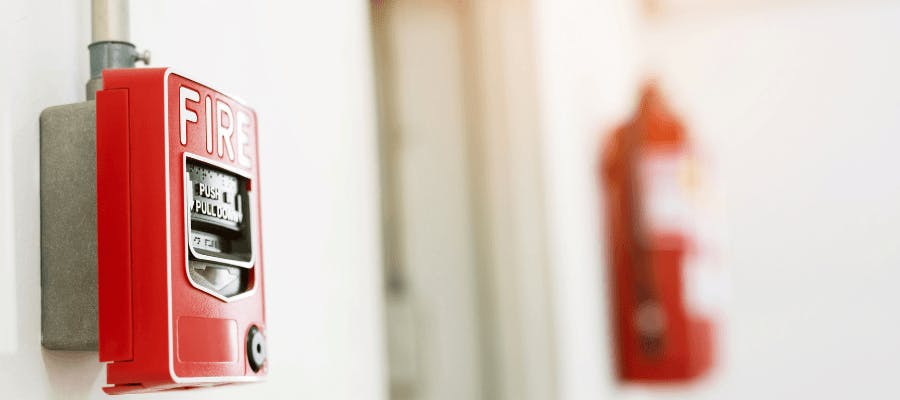First published on Friday, October 6, 2023
Last updated on Friday, October 6, 2023
In any workplace, the safety of employees should always be a top priority. It’s vital to stay informed and updated on the latest fire safety laws to protect your employees and your business long-term.
On October 1st, key updates impacting businesses came into effect. These new and updated regulations aim to enhance workplace safety and reduce the risk of fire-related accidents.
So, let’s dive into the changing regulations. Read on to find out how to stay on the right side of the law and keep your staff safe.
Key changes in the regulations
The primary piece of legislation governing fire safety in England is the Regulatory Reform (Fire Safety) Order 2005 (FSO). This order has been amended to include several important changes:
Responsibility for fire safety
One of the central changes introduced by the Fire Safety Act 2021 is the concept of "responsible persons". The responsible person (usually you) now has a legal duty to manage the risk of fire.
This means you must make sure fire safety measures are in place and effectively maintained. This includes not only the physical structure of the building but also the safety of its occupants.
Risk assessments
You must conduct thorough fire risk assessments for your premises. These assessments should identify potential fire hazards, evaluate the risk to employees and others, and implement measures to reduce these risks. This process should be ongoing, with regular reviews and updates.
External wall systems (EWS)
The new regulations pay specific attention to external wall systems and cladding. You must make sure that any external wall system is safe and does not pose a fire risk. This is particularly relevant for high-rise buildings and those with cladding systems.
Means of escape
You must provide clear and unobstructed means of escape for all occupants by way of making sure exit routes are properly maintained and clearly marked, and that all employees are familiar with evacuation procedures.
Fire detection and warning systems
You are responsible for making sure appropriate fire detection and warning systems are in place and maintained. This includes fire alarms, smoke detectors, and emergency lighting.
Competent professionals
You must engage competent professionals to assist with fire safety measures. This involves appointing a fire risk assessor who is deemed competent and may include seeking advice from fire safety consultants, engineers, or specialists in fire prevention.
Ensuring compliance with the updated regulations
To make sure you’re compliant with the updated regulations, you can follow these five steps:
1. Understand the regulations
You should familiarise yourself with the Fire Safety Act 2021 and its associated guidance documents to understand your responsibilities fully.
2. Conduct regular Fire Risk Assessments
Regularly review and update fire risk assessments, taking into account changes in the workplace, occupancy, or building structure.
3. Invest in fire safety training
Make sure that your employees are trained in fire safety procedures and evacuation plans. Regular drills and training sessions can significantly improve preparedness.
4. Maintain fire safety equipment
Regularly service and maintain fire detection and warning systems, as well as fire extinguishers and other safety equipment.
5. Engage experts
Consider seeking the assistance of fire safety professionals to conduct assessments and provide expert guidance on compliance.
Failure to comply with these new fire safety laws can result in significant penalties, including major fines and imprisonment for serious breaches. It’s essential to take your responsibilities seriously and prioritise fire safety.
Having the right tools to ensure fire safety
The updated fire safety regulations that are now in effect represent a significant shift in the responsibilities of employers and business owners. These changes prioritise the safety of employees and occupants and place a stronger emphasis on proactive fire risk assessment and management.
By having an end-to-end health & safety software like BrightSafe you can not only meet legal obligations but also ensure the safety and wellbeing of your staff.
And, by understanding the regulations, conducting regular risk assessments, and investing in fire safety measures, you can create a safer workplace and contribute to a society where the risk of fire-related incidents is significantly reduced.
To learn more about the impact of these changes on your business and the necessary measures you need to take to ensure legal compliance, you can sign up for our upcoming FREE webinar: NEW workplace fire safety laws: Everything you need to know.
Plus, for a more in-depth look at the updated fire safety regulations, read the New Fire Safety Guidelines 2023: Updates and regulations.
Have more questions about fire safety?
Just ask BrightLightning:
Can fire doors be propped open?
Fire doors should not be propped open. Hold-open devices may be installed where doors may need to be open for operational reasons as these will close automatically upon fire alarm activation, where installed. Insurance providers may not pay compensation when it is deemed that fire doors were not effectively used.
What should I do if the final fire exit door leads onto a road or car park
It's important that the exit is kept clear at all times and isn't obstructed. You could consider putting up a no parking sign to prevent cars from parking directly in front of the final exit or installing barriers.
Who needs fire safety training and who should provide this?
All your employees should receive fire safety training when they are first recruited and over the time of their employment to ensure they know what to do in the event of a fire emergency.





